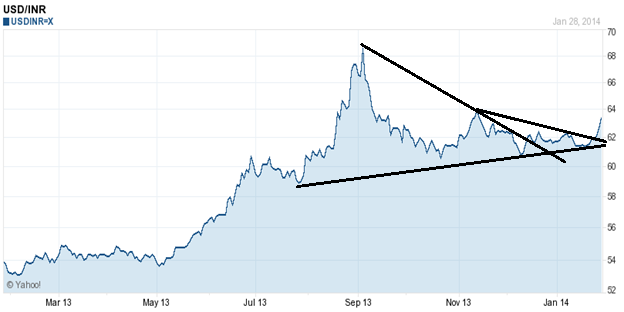The Indian Rupee has been spared the worst of the recent emerging market currency problems, but it remains especially pressured by traders ever since last May. Issues may persist the next several weeks.
The Indian Rupee has spent the past several months in a tight range, at least compared to the more consistent selling seen in the middle of 2013. The Rupee, like other emerging market currencies such as the Brazilian Real, South African Rand, and Russian Ruble, has been under pressure ever since Federal Reserve Chairman Ben Bernanke warned that the central bank would end its QE3 bond-buying program.
The May 2013 warning has had a very real impact on emerging market currencies. It seems that investors have just gotten the memo in 2014 as movement in the foreign exchange markets has become more volatile in January. The Argentinian Peso had a historically bad day within the past two weeks, falling about -17% in just a few hours. That’s very obviously a bad sign for any financial instrument!
Emerging market central banks are fighting to keep their currencies above water.
On Tuesday, in order to help improve the appeal – the interest rate differential - of the Indian Rupee during a time when stress in emerging markets is rising, the Reserve Bank of India made a surprise announcement. Economists were expecting the Reserve Bank of India to keep its benchmark interest rate unchanged at 7.75%. Instead, the main rate was raised to 8.00%.
The differential between the Reserve Bank of India’s and the Federal Reserve’s benchmark interest rates increased to 7.75% from 7.50%, which the Reserve Bank of India is hoping will help keep traders wanting to keep “carrying” on.
Forex Technical Analysis: Indian Rupee (USD/INR) Chart (Intraday)

Source: Yahoo! Finance
The Reserve Bank of India’s surprise 0.25% rate hike was desired to help the Indian Rupee, or put another way, the USD/INR exchange rate is desired to fall. So far, so good: the chart above shows how the USD/INR exchange rate has pulled back. The daily chart warns that a breakout may have occurred already:
Forex Technical Analysis: Indian Rupee (USD/INR) Chart (Daily)

Source: Yahoo! Finance
Ultimately, if a bullish break higher is developing in USD/INR as the triangle on the daily chart above suggests, then the Federal Reserve’s meeting this week is the first event on the horizon to watch out for.
From a distance, the relationship between Federal Reserve policy and emerging market problems appears an unlikely union. But in the age of globalization and electronic money, stimulus funds can travel anyway. The Federal Reserve’s low main interest rate of 0.25% has forced traders to find yield elsewhere, fueling what is more commonly known as the “carry trade.”
What is the “carry trade?” It’s when a trader sells a currency with a low interest rate and uses the proceeds to buy a currency with a relatively higher interest rate. By ‘carrying’ the position each day past 5pm EST (the end of the global trading day), traders can earn the interest rate differential.
This interest rate differential is the reward for traders taking on the extra risk. The Reserve Bank of India is essentially raising the stakes to remain invested in the Indian Rupee by bolstering the “carry trade.” DailyFX Trading Instructor Richard Krivo explains the concept of the “carry trade” in more detail here.
original source

 By
By 

